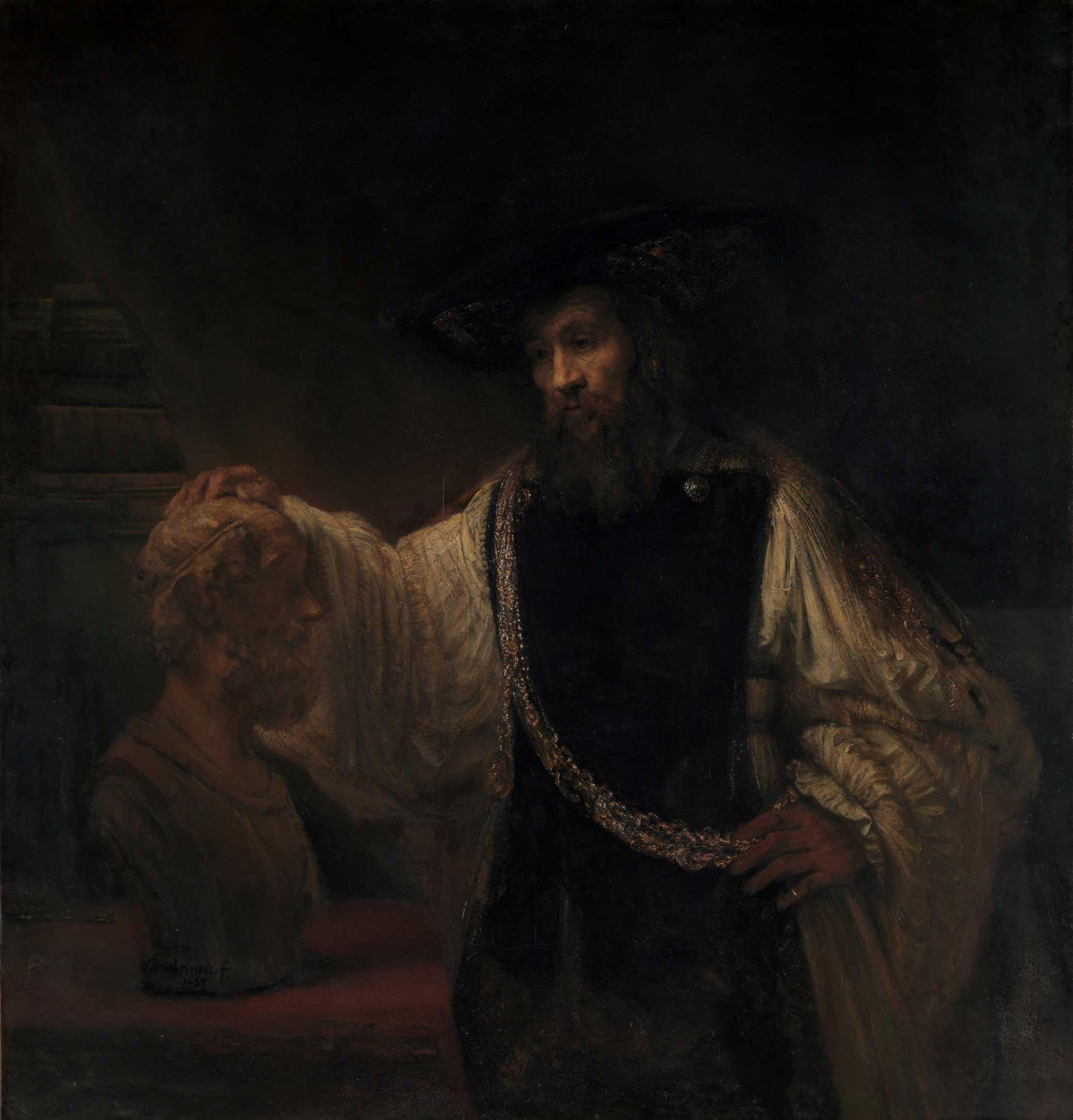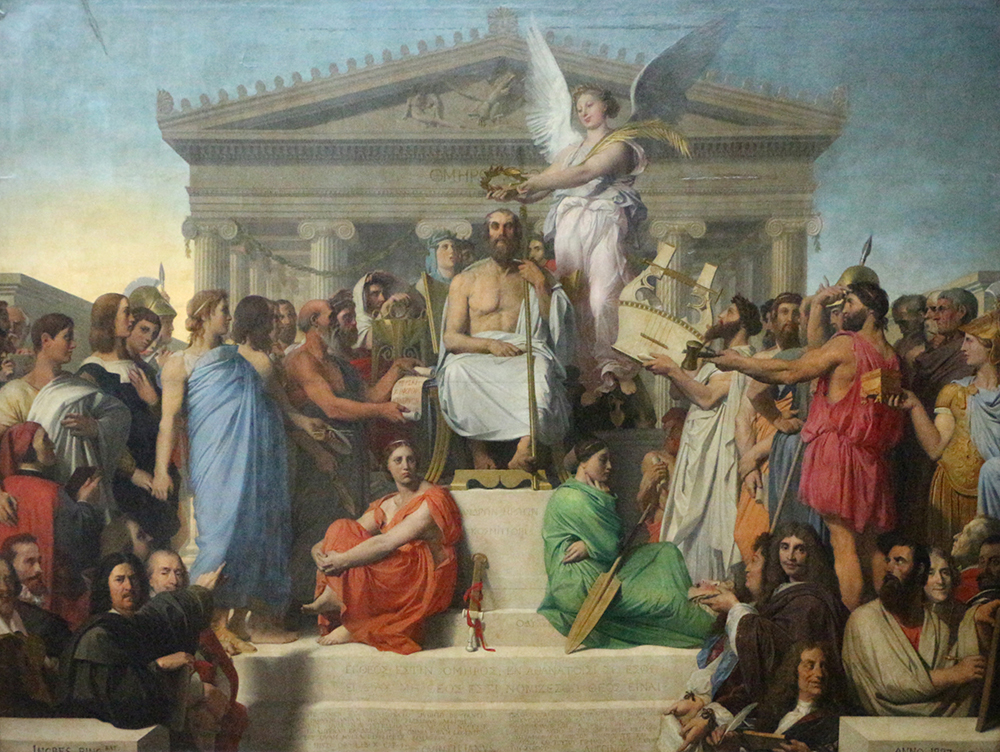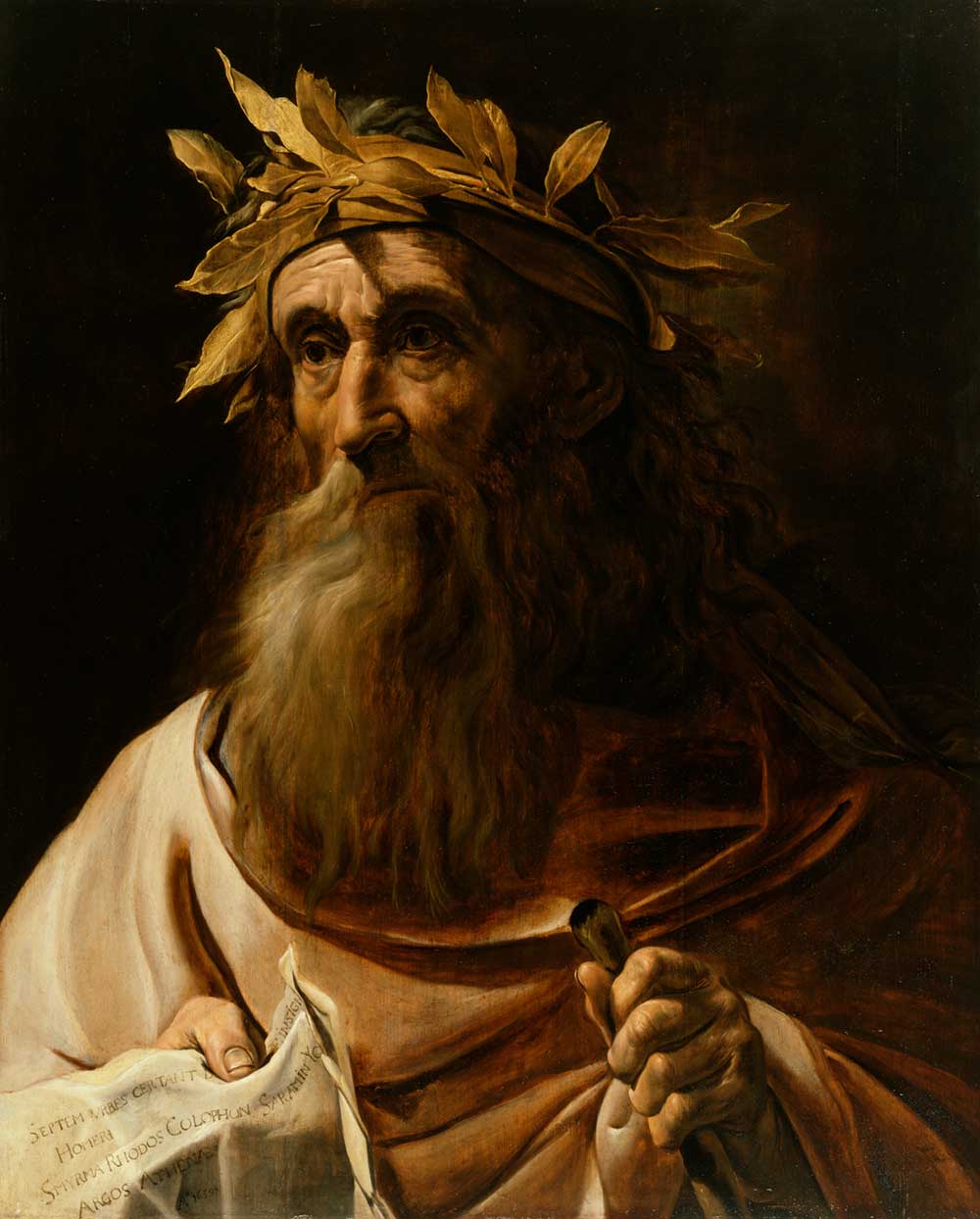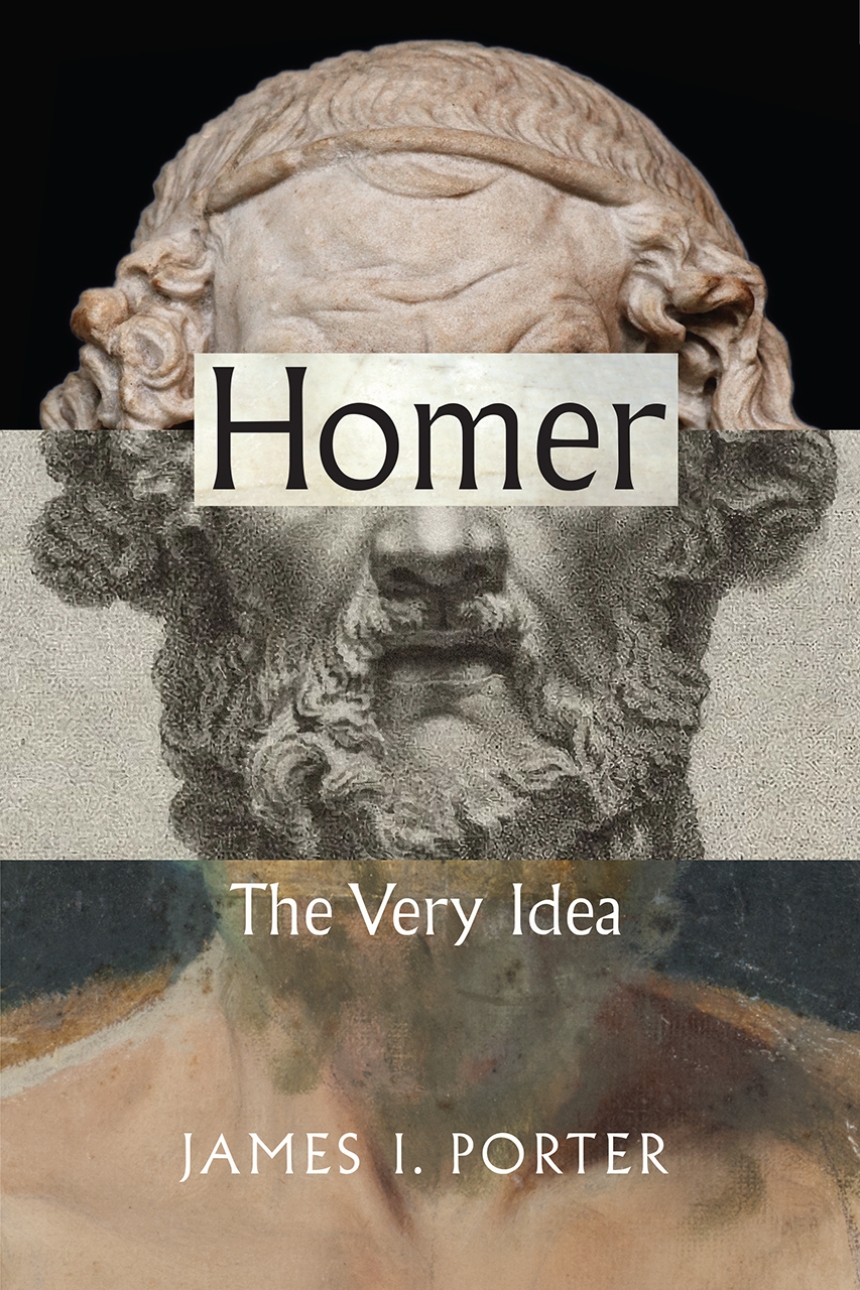
Aristotle with a Bust of Homer, by Rembrandt van Rijn, 1653. The Metropolitan Museum of Art, purchase, special contributions and funds given or bequeathed by friends of the Museum, 1961.
The earliest known image of Homer comes to us in the form of a Roman imperial copy of a head, now in Munich, that once belonged to a standing life-size statue dedicated at the Temple of Zeus Olympia in 460 bc. Later examples of original portraiture, each engendering families of sibling copies, run from the High Classical period (430 bc) to the Hellenistic and Roman periods and then on into later antiquity. As we know from ancient travelers and other writers, considerably more visual representations of Homer once existed in sundry media, sizes, and poses, but these were lost over time.
In most of the surviving images, Homer is shown as old and blind, listening quietly within to whatever divine voice moves him. In some he is sighted and, not infrequently, shown silently reading. His hair can be either elegantly coiffed or disheveled, sometimes with a bald forehead, but not in every case. The disparity is considerable. At a minimum, the variances serve as a confession of ignorance, which in turn reminds us that the mystery of Homer was as great and as insoluble in antiquity as it is today.
In his Natural History Pliny the Elder is frank about the difficulties of lighting upon the “true” Homer, visually speaking, given the plethora of Homers in circulation in antiquity. The mere proliferation of these portraits betokens an underlying need and its inevitable frustration:
We must not pass over a novelty that has also been invented, since likenesses, if not of gold or silver, then at all events of bronze, are set up in libraries in honor of those whose immortal spirits speak to us in those same places. Not only that, but those whose likenesses we no longer have are modeled ex nihilo, and a sense of loss gives birth to countenances that have not been handed down to us, as in the case of Homer.
Pliny knew very well that representations of Homer were imaginary projections and nothing more, all of them driven by a powerful desire to put a face on a name. Nor was Pliny’s insight exceptional among the ancients. Whenever they were faced with a claim about Homer or his likeness, they too had to struggle with competing impulses, which typically took the form of the admission “I know very well that the evidence of Homer before me is the result of illegitimate imaginary construction, a mere stab in the dark, but I will treat it as if it were authentic, valid, and probative just the same.” Such is the logic of fetishistic illusion, which overcomes the oddity of the experience that Pliny so perceptively puts his finger on: For how can you feel a sense of loss for something that you never possessed to begin with? One obviously can, which does not yet give us much information about the nature of the loss; it merely confirms its effects. The effects of this kind of thinking were confirmed in practice: Homer may have been lost forever, but his cultural value and cachet were inextinguishable.
Evidently, the mystery of Homer could chafe and attract in equal measures, and at one and the same time. The more one sought to pin down facts about Homer’s physical appearance and his life, the harder it proved to do so. As the urge grew greater, so did the corresponding anxiety. After antiquity, attempts to capture Homer’s likeness in a visual medium continued to rely almost exclusively on citations and re-elaborations of the ancient tradition’s own guesswork: they constituted a continuation of the ancient series.
Ancient portraiture solved the problem of representing Homer by skirting it. Artists produced images that declared their generic character with an iconography that in effect said, This is (a representation) of Homer. Then they added details that gave their images an effect of the real and the illusion of authenticity: a twist of hair here, a crease of flesh there, extra contouring on the cloak, a certain heaviness in the eyelids, and so on. Where the particulars failed to convince, the typological character of the portrait stepped in to assure the beholder’s gaze that it was at least trained on an identifiable subject: portrayed in any given instance was, if not the reality, then at least the idea—someone’s idea, or antiquity’s collective idea—of Homer.
The Louvre Homer, sculpted by the French neoclassical painter Jean-Auguste-Dominique Ingres in the nineteenth century, bears the marks of old age—sagging eyes, slackening facial musculature, receding hair (in an archaizing style), flowing beard—while the figure as a whole reposes in quiet and expressionless grandeur. But the apparent realism is a ruse, the more so as several different sculptural types of Homer existed in antiquity, each with its own distinct set of features and lineage. Looking at this scatter of images, one would literally have to shut one’s eyes to be able to say that they were depictions of the selfsame figure.

Given this array of possibilities, identifications of Homer are often difficult to make with any certainty, and they are more or less taken on faith, except when an inscriptional tagline labels the subject and clinches the identification. In several cases, the alleged portraits border on being all-purpose and generic—plausibly representing a god (usually Zeus), a tragic poet, a sage, or royalty—and hence of disputed identity.
Homer was a myth not only from his first mentions, whenever those occurred, but before them as well, because he was already a mythical figure in his poetry. The ancient visualizations of Homer are thus governed by the underlying paradoxical logic of a type/token dilemma: the token is itself a type; what each token depicts is not Homer but “Homer,” an instantiation of the idea of Homer.
To speak about “the life of Homer” was and still is to say something about nothing: the phrase is a contradiction in terms. Homer could not be identified, and he may never have lived. And yet the complete ignorance about Homer in antiquity triggered the opposite reaction. The least known and greatest of early poets gave rise to an unappeasable biographical itch. As with nature, so too with Homer: literary history abhors a vacuum. Faced with so much uncertainty surrounding the author of the Iliad and the Odyssey, the ancients rushed to fill in the gaps, in essence producing a biography of the poet who, it was assumed, must have lived at some point in the past like any historical individual and whose exploits and experiences, both good and bad, could be traced in narrative stories about him. Homer had to be equipped with a genealogy, a pedigree, a place of origin, a curriculum vitae, a list of titles, a knowable death, and a place of burial. Out of this necessity sprang an entire genre of writings about the life of Homer, known as the Homeric Lives, that flourished throughout antiquity and spread into early modernity, as with Anne Dacier’s 1711 Life of Homer. Homer was not alone in having been awarded a series of Lives; other poets enjoyed this fate, too. He simply stood out as having spawned the greatest number and the most elaborate and most discrepant of these, and from an early date at that—at least from the end of the sixth century, and very likely earlier.
The result was a large mass of speculations, much of it late (Hellenistic to Byzantine), at least in the form that has come down to us, but very likely with antecedents in early oral legends and lore dating to the time when Homer’s name first came to be attached to the two monumental poems, roughly around 700 bc. Accounts like these are records not of Homer’s biography but of attempts to wrestle with an insoluble and increasingly unwieldy tradition or lineage of traditions that sprang up around Homer. The Lives and their spin-offs are in fact collective hallucinations, crowd-sourced documents that have been multiply overwritten. And because of the way they continued to grow and change over time, they often seem to have had more life to them than Homer ever had himself. Partly owing to the nature of the genre and partly owing to its sprawling existence across long stretches of space and time, the limits on this kind of fantastical guesswork were few, and the stories that were told varied wildly within and across each compilation of Lives and their derivatives that accumulated over the centuries.
Their tone varied as well. At times, the stories were entertained in all earnestness. At other times, they were indulged in for the sake of the exercise or simply for high jinks. Although the Lives of Homer were in some sense hagiographic, they were not always this, and given their compulsively conservative bent (they tended to hoover up every conceivable fact that was ever told about Homer’s person) and given the amount of scurrilous detail that attached to Homer, no representative Life could ever really be a bona fide hagiography. Many of the speculations that were put up for sale were created not as serious claims but to expose the ignorance of others, while the truthfulness of any claims about Homer immediately fell under the suspicion of being unverifiable. To narrate a detail about Homer’s life was to enter into a literary Wild West.
The starting point for everyone—the only secure foothold anyone had—was the poems, which were mined for clues to Homer’s life and circumstances. Places and dialects could be used to indicate the extent of Homer’s travels. Poetic characters were roped into his curriculum vitae and made to embody teachers, mentors, relatives, lovers, or thinly disguised self-portraits (Helen’s tapestry from Iliad book three is called “a striking emblem of Homer’s own poetry”; Demodocus, the blind Phaeacian singer from the Odyssey, is said to be a “self-portrait” by Homer; Odysseus’s penchant for tall tales and downright lies and his polymathy are frequently assimilated to Homer’s qualities as a poet or sage). Out of this same speculative urge arose a further subgenre of literary phantasms that imagined poets not only as once living and eventually dead but also as ghostly revenants who rose from the dead and made themselves available for visions and conversations in their afterlife. Homer took pride of place here too. Finally, there was another line of speculation that sought to understand who Homer was based on what he said in his poems—namely, the tendency to imagine different racial and ethnic identities for him, all of this depending on the time, place, and mood of the interested party. In such cases, Homer’s credentials as an ethnic Greek were stretched to an uncomfortable limit.

The lore that accumulated around Homer was prolific. No other poet had so many lives, or Lives. (Some ten or so of these have survived, depending on how they are counted. Many more must have existed.) Homer was born of a river god and a nymph. He had up to six different fathers, one of whom was Odysseus’ son, Telemachus, another being “a teacher named Phemius” (Odysseus’ court bard), who, it was said, hailed from Smyrna and took on the role of a stepfather. He had as many mothers as he had fathers, one candidate being Polycaste, the daughter of Nestor (the Greek warrior and elder statesman who figures prominently in both epics). He was born in at least seven places (this was the official number; the number grew as the traditions did) and was imagined to have lived either at the time of the Trojan War or as many as four centuries afterward. According to one later source, he fell madly in love with Penelope, moved to Ithaca, and gave her a starring role that rivaled that of her husband. According to another, Homer was the younger cousin of his own sometime rival, Hesiod. When all other evidence gave out, there was always Homer’s name (Homēros), which could serve as a clue to his identity and fate: homēros (a noun) was variously understood to mean “hostage,” “bondsman,” “guide,” “fellow traveler,” “blind person,” or “the one-who-does-not-see” (ho mē horōn), depending on the dialect and the claimants.
One source uniquely suggests that Homer derives from his father’s name, Omyres. (The name occurs nowhere else and has no obvious sense.) Modern and contemporary philologists have come up with speculations of their own that are no less inventive or fanciful, for example deriving Homer from the verb homērein, “he who fits [sounds/voices/verses/songs] together in unison” or “in tune.”
In any event, Homer was no more than a nickname given to him by others and an afterthought. His original name was said to be Meles, Melesigenes, Melesagoras, or Melesianax, usually in honor of his father, the river god Meles in Smyrna, near the coast of Asia Minor, but otherwise, in a minority of cases, as a remembrance of his place of birth “by the river Meles”—a far less illustrious pedigree, as it deprived him of divine ancestry. Either way, the tradition knew that something was afoot here. Homer’s name was clearly not his own.
The reasons for the name change were mired in controversy and in even greater obscurity. Behind the shuffle from myth to wearisome rationalization without consensus was a fact that needed to be explained. Settling on one or another of Homer’s names as his “actual” name, or arguing for the meaning of any individual name, misses the point and distracts from the nub of the issue, which is contained in the mere fact of the name change itself. Inexplicable in its own terms, what the change tells us is that Homer had no proper name, indeed no proper identity, and the tradition knew this to be the case. Not even Homer knew who he was.
Reprinted with permission from Homer: The Very Idea by James I. Porter, published by the University of Chicago Press. Copyright © 2021 by The University of Chicago. All rights reserved.
